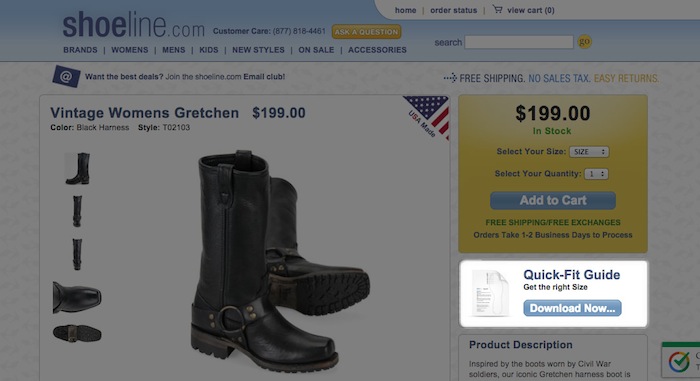Finding the Right Fit — Reducing Online Returns (VIDEO)
4 Min Read
Industry research finds that one in four garments purchased online is being returned—5 times higher than offline purchases—and it’s mostly because of poor fit. While this isn’t a new problem, it is an issue that can drastically impact a retailers bottom-line as well as leave a customer with an negative shopping experience.
The challenge of clothes shopping online
Anyone who has ever shopped online knows that trying to find the perfect fitting pair of rag & bone denim is much easier done offline in a brick + mortar retail store where you get the full sensory experience, actually seeing and touching the physical product.


The offline retail environment allows customers to channel their inner Goldilocks and try on items limitless times in a fitting room until they find the product that fits “just right”. While some multichannel retailers have the advantage of both a brick + mortar and online presence, it’s a clear challenge for the increasingly growing number of pure-play ecommerce brands, whose business solely exists online. Online size and fit guides have been helpful but, major challenges still exist in apparel with the lack of standard sizing conventions across brands and countries. Until a consumer becomes familiar with a brand’s specific style and how it fits them, it can still be very challenging to fully meet their sizing expectations when purchasing online.
Quick Solutions to Help Customers Find the Right Fit Online
So what are quick and easy solutions retailers can use to help customers find their fit and reduce the need for returns in the first place?
1. Provide your customers with better product information and product photography. Industry reports have found that customers are less likely to return a garment the more pictures they can see while ordering.
2. Leverage online reviews and rating systems.
3. Provide context and scale of items. Displaying the size and height/measurements of the model can be very helpful for your customers to get an idea of how the item may fit on them.
4. Size guides, charts, downloadable quick-fit guides, how to measure videos
5. Use video. Although this can be a very expensive and time-consuming to produce, the added conversion benefits are worth incorporating into your overall content strategy.
6. Be green. Showing customers of the environmental impact that ordering multiple sizes of an item has helped to deter those shoppers taking advantages of retailers free or lenient return policies.
7. Live Chat with shoppers or have Customer Service via email or call service that’s dedicated to answering sizing questions
Imitate the Fitting Room Experience with Virtual Try-On Technology
While the above mentioned strategies can definitely help provide more product information to your customers, they still don’t fully replicate the fitting room experience. This is why retailers continue to explore virtual fit technologies.
For instance, in 2007, Paxar introduced the interactive RFID mirror, a device which allowed shoppers viewing a RFID tagged clothing item in the mirror to have relevant product information, suggested accessories and upsells displayed to them “snow white style” through the mirror.
eBay Acquisition of PhiSix Fashion
More recently, companies like Me-Ality have leveraged body scanners, 3D and photo-accurate virtual fitting rooms, and augmented reality scenarios in order to simulate the try-on experience. In fact, earlier this year, one of Corra’s partners, eBay Inc., acquired PhiSix Fashion labs, a company who’s technology allows consumers to see how clothes fit, look and move in different environments without actually having to try them on (i.e. online).
“PhiSix’s technology enables consumers to understand the fit and movement of clothes in an online shopping environment,” said Steve Yankovich, vice president of Innovation and New Ventures of eBay Inc. “Consumers can experience the merchandise in a more efficient and impactful way, which we believe will drive sales for retailers and create a delightful experience for shoppers.
While most of these emerging fit technologies have yet to become mainstream, they are standard for quite a few forward thinking brands and retailers. Below is a brief survey of what’s in the market today.
1. Fit.me
2. Virtusize
http://vimeo.com/49443031
3. Downloadable Quick-Fit Size Guides


4. Rotator and 3d-virtual try-on for eyewear


Other Topical Articles to Read
2. http://www.embodee.com/#what-we-do
4. http://www.entrepreneur.com/article/226091
5. http://www.t-immersion.com/trylive/trylive%E2%84%A2-augmented-reality-fashion
Photo via POPSugar, Shoeline, Eyefly
____________
[rendertool][type_person][prop_name]Kristina Burbich[/prop_name] is [prop_job]Commerce Strategy Consultant[/prop_job][/type_person] at [type_corp][type_corp][prop_desc][prop_name]Corra[/prop_name], a [prop_loc]New York[/prop_loc] and [prop_loc]Los Angeles[/prop_loc] based digital agency [prop_mkffr]that delivers high performing ecommerce solutions for fashion, lifestyle and beauty brands and retailers.[/prop_mkffr] With a team of more than 100 ecommerce strategy, creative and technology professionals Corra delivers rich shopping experiences across all channels and devices by balancing the right amounts of branding, commerce and content for each client. Corra is trusted by retailers of all sizes to implement and support Magento Enterprise, Demandware and hybris platforms. [/prop_desc][/type_corp][/rendertool]
